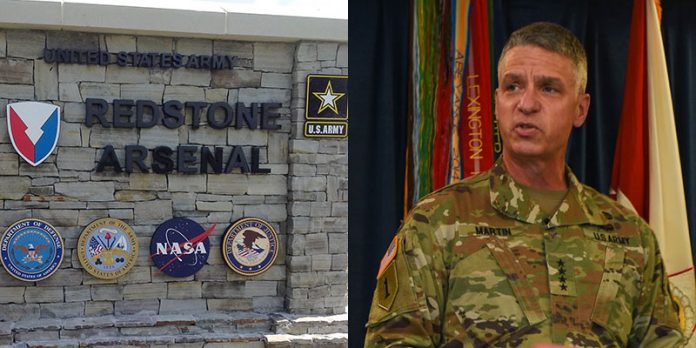Vice Chief of Staff of the Army Gen. Joseph Martin recently spoke with leaders and experts from several commands and industry partners to learn more about current readiness and modernization initiatives at Redstone Arsenal.
Martin said being able to meet directly with people, and see and touch things firsthand, is incredibly valuable to furthering his understanding and ability to convey the importance of the work being done at the installation.
“It’s so much easier to explain something when I’ve seen it with my own eyes,” Martin said. “Spending just a day here is worth 20 times the amount of time that I could spend being briefed in the Pentagon.”
He described Redstone Arsenal as an important national asset and noted that its value extends well beyond its 44,000 employees and $18 billion economic impact locally.
“The Army couldn’t do its mission without this team here,” he said. “It’s so much more than the impact of this installation on the community; it’s the impact it has on the Army and the future of the Army.”
During his visit, Martin met with Gen. Ed Daly, Army Materiel Command commander, and several key staff at the AMC headquarters where he was briefed about how the materiel enterprise is enabling the Army priorities of people, readiness and modernization.
Specifically, Daly discussed AMC’s support to the Joint Force, the fight against the COVID-19 virus, the Organic Industrial Base 15-year modernization plan, AMC’s role in the Army’s Regionally Aligned Readiness and Modernization Model, and investments to Army housing and other key infrastructure at our installations worldwide.
Martin said AMC and Redstone Arsenal play an important role in supporting the more than 140,000 Soldiers the Army has deployed around the world.
“Each and every one of them have needs – they need parts for their equipment, they need to be fed, they need to be taken care of – and really where it all starts is right here at the Army Materiel Command headquarters which is responsible for the Strategic Support Area in the United States and well beyond to the tactical edge wherever it may go,” he said.
Martin began his visit to Redstone Arsenal at the Army Rapid Capabilities and Critical Technologies Office, where he discussed the development of rapid prototyping efforts in hypersonics, Mid-Range Capability and directed energy.
Established to spearhead rapid prototyping and deliver residual combat capabilities to Soldiers, the RCCTO is on pace to deliver strategic outcomes, and other emerging technologies, to ensure the Army and its joint partners can engage across all domains to deter and defeat near-peer threats.
“This is truly a unique organization and what we are doing is fundamentally different than upgrading existing capabilities,” said Lt. Gen. L. Neil Thurgood, director of Hypersonics, Directed Energy, Space and Rapid Acquisition, who oversees the RCCTO. “These are systems that have never been used on the battlefield before and will change the future fight. The innovation that is happening here at Redstone and across industry, government and the Army is truly energizing and critically important.”
The RCCTO is responsible for prototyping a land-based Long Range Hypersonic Weapon to Soldiers by fiscal 2023. It is also developing a ground-launched, prototype MRC for delivery to an operational battery in fiscal 2023. In fiscal 2022, the Army’s Directed Energy Maneuver-Short Range Air Defense, a 50 kilowatt-class High Energy Laser weapon system, will be fielded to a Stryker platoon.
At Space and Missile Defense Command, Martin visited the Technical Center’s Payload Demonstration Lab; Positioning, Navigation, and Timing Resiliency Lab; and the Concepts Analysis Lab. He also received a briefing on the SMD Center of Excellence and visited their Joint Air Defense Operations Center.
“We are glad Gen. Martin had the opportunity to come to SMDC and see firsthand how the command is leading the Army and joint force into the future,” James Johnson, deputy to the SMDC commander, said. “Our Center of Excellence and Technical Center are at the forefront of the nation’s space, missile defense and high altitude technologies and enable battlefield dominance today as well as enabling the next generation to prevail in future conflicts.”
Johnson said Martin’s visit was a unique opportunity to engage directly with one of the Army’s most senior leaders and policy makers.
“Our goal was to provide Gen. Martin with the information necessary to make informed decisions,” Johnson said. “The visit gave us the opportunity to show an Army senior leader how SMDC is preparing to meet future conflicts and operational challenges as part of the Army’s effort to modernize and build a multi-domain operations-capable force.”
Martin also visited with leaders from the Program Executive Office for Missiles and Space, Program Executive Office for Aviation, and the Redstone Test Center.
“What I see is an incredible synergy at this installation amongst the acquisition enterprise; the research, development, testing and engineering community; and the sustainment enterprise of the United States Army, and it’s a team that works very well together,” Martin said.
This article was first published in the May 5 edition of The Redstone Rocket and it is being published in Yellowhammer News by permission of the Redstone Arsenal Garrison Command.
Don’t miss out! Subscribe to our email newsletter to have all our smart stories delivered to your inbox.



